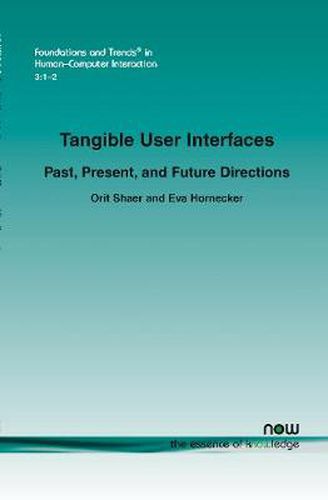Readings Newsletter
Become a Readings Member to make your shopping experience even easier.
Sign in or sign up for free!
You’re not far away from qualifying for FREE standard shipping within Australia
You’ve qualified for FREE standard shipping within Australia
The cart is loading…






This title is printed to order. This book may have been self-published. If so, we cannot guarantee the quality of the content. In the main most books will have gone through the editing process however some may not. We therefore suggest that you be aware of this before ordering this book. If in doubt check either the author or publisher’s details as we are unable to accept any returns unless they are faulty. Please contact us if you have any questions.
In the last two decades, Tangible User Interfaces (TUIs) have emerged as a new interface type that interlinks the digital and physical worlds. Drawing upon users’ knowledge and skills of interaction with the real non-digital world, TUIs show a potential to enhance the way in which people interact with and leverage digital information. However, TUI research is still in its infancy and extensive research is required in order to fully understand the implications of tangible user interfaces, to develop technologies that further bridge the digital and the physical, and to guide TUI design with empirical knowledge.
This paper examines the existing body of work on Tangible User Interfaces. This book starts by sketching the history of tangible user interfaces, examining the intellectual origins of this field. It then presents TUIs in a broader context, survey application domains, and review frameworks and taxonomies. The authors also discuss conceptual foundations of TUIs including perspectives from cognitive sciences, psychology, and philosophy. Methods and technologies for designing, building, and evaluating TUIs are also addressed. Finally, they discuss the strengths and limitations of TUIs and chart directions for future research.
$9.00 standard shipping within Australia
FREE standard shipping within Australia for orders over $100.00
Express & International shipping calculated at checkout
This title is printed to order. This book may have been self-published. If so, we cannot guarantee the quality of the content. In the main most books will have gone through the editing process however some may not. We therefore suggest that you be aware of this before ordering this book. If in doubt check either the author or publisher’s details as we are unable to accept any returns unless they are faulty. Please contact us if you have any questions.
In the last two decades, Tangible User Interfaces (TUIs) have emerged as a new interface type that interlinks the digital and physical worlds. Drawing upon users’ knowledge and skills of interaction with the real non-digital world, TUIs show a potential to enhance the way in which people interact with and leverage digital information. However, TUI research is still in its infancy and extensive research is required in order to fully understand the implications of tangible user interfaces, to develop technologies that further bridge the digital and the physical, and to guide TUI design with empirical knowledge.
This paper examines the existing body of work on Tangible User Interfaces. This book starts by sketching the history of tangible user interfaces, examining the intellectual origins of this field. It then presents TUIs in a broader context, survey application domains, and review frameworks and taxonomies. The authors also discuss conceptual foundations of TUIs including perspectives from cognitive sciences, psychology, and philosophy. Methods and technologies for designing, building, and evaluating TUIs are also addressed. Finally, they discuss the strengths and limitations of TUIs and chart directions for future research.